Arethusa Falls
Plenty of water, all we need now is some cold. Please!
Arethusa Falls
Crawford Notch NH – 12-6-2015
At nearly 200 feet high, it is the highest waterfall in NH
Arethusa Falls
Crawford Notch NH – 12-6-2015
At nearly 200 feet high, it is the highest waterfall in NH
The beginning of this ice season has been anything but consistent. We’ve had thigh deep snow topping out of Huntington Ravine in October followed up by spring-like temperatures on the high summits for weeks with only splashes of short cold spells here and there. Usually I can get a sense of what the ice conditions will be like, but this year I’ve been off my game. Two weekends ago, I stopped thinking about ice and went for a three day backpack in the Wild River Wilderness. Just this past weekend, I thought there wouldn’t be much to climb out there, so I donned my summer trail running shoes and headed up and around the side of Mt. Jefferson with some friends.
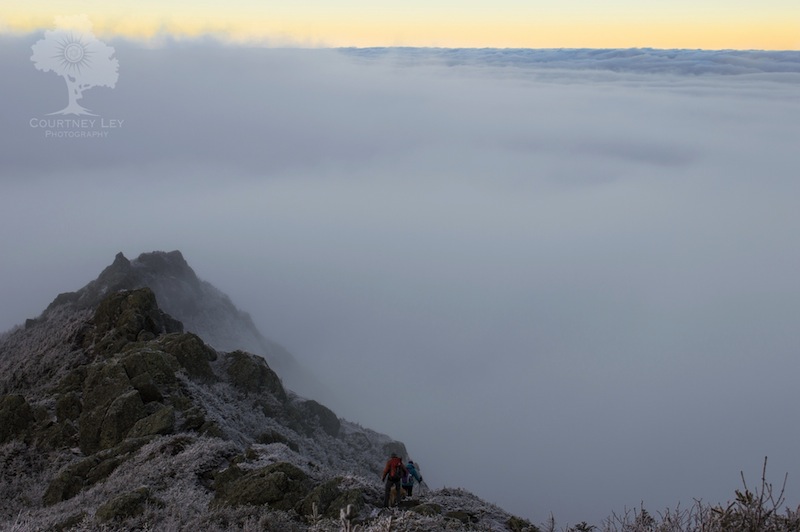 I found out that evening, when my phone buzzed with picture messages, that I was dead wrong. While I was in and over the clouds that day, there was a duo climbing what was likely the longest and fattest ice line in northeast as of that moment. That was Hillman’s Highway in Tuckerman Ravine, and yes, there was a lot of ice. At least the beautiful undercast was worth missing out on the climbing action.
I found out that evening, when my phone buzzed with picture messages, that I was dead wrong. While I was in and over the clouds that day, there was a duo climbing what was likely the longest and fattest ice line in northeast as of that moment. That was Hillman’s Highway in Tuckerman Ravine, and yes, there was a lot of ice. At least the beautiful undercast was worth missing out on the climbing action.
Others tackled Tuckerman Headwall on the day, the day before and the one after. Despite it getting sun baked, the ice seemed to hang in there just enough. Huntington Ravine also saw some action, with Odells Gully, not surprisingly, seeing the most traffic. Check out the condition reports for information on those climbs.
Elsewhere in New Hampshire, Alden Pellett explored the Big Slide area up Mt. Lafayette on last Sunday to find a thin runnel of ice from bottom to top.
Up in Lake Willoughby, things are admittedly looking a little sad. This picture of the Center Tablets about sums it up.
Smuggler’s Notch has been like a bad relationship: on, off, on and then off again. Like some mystical land, the routes appear and disappear in mere hours and at random times.
Reports from last Saturday in the notch confirmed there was a lot of moving water and some verglass on the rocks in the gullies but the ground wasn’t frozen yet. Jeff’s Slide appeared as a thin apparition and then disappeared again this week with the warm temperatures. But there’s hope! The road officially closed and I’m sure climbers will be heading in this coming weekend to see what’s there.
News has been quiet in the Adirondacks, but I’m sure that doesn’t mean the locals haven’t been climbing. The last bird I saw told me Chouinard’s Gully was climbed in super thin conditions, but that was days ago and the way this season has been going, that fact becomes totally irrelevant.
So what now? What’s going to happen this weekend? What the f&@k is going on with this weather? It’s anyone’s guess, but the forecast calls for a high of 40 degrees on the summit of Mt. Washington Saturday. Go figure that it’s snowing and cold up there as I write this article.
What’s been going on in your neck of the woods? Find some good ice? Let me know at courtney@neice.com! Till then, good luck out there!
I’ll leave you with these videos, as they sum it up best. Some great footage of the changes in Tuckerman Ravine, courtesy of NEice Community member, Matt Bowman! Thanks for sharing these.
Special thanks to Nick Yardley, Alden Pellett, Tim Farr and Matt Bowman.
AERIAL VIDEO AND PHOTOS IN A BACKPACK
Solo does more than just get cool aerial shots: It gives me a full Cinematic toolkit in the software — “an automatic crane, dolly, jib, boom, slider, tripod and, of course, helicopter”.  Now I can concentrate on filming and what the camera sees and let Solo from 3DR do the real work of flying. I have outfitted Solo with two Go Pro Blacks. One with a standard wide angle lens and one with a special aerial lens of 31 mm (no fish eye). These cameras can shoot 4K and up to 120 fps. Everything I need, and it all fits in a backpack, ready to take into the mountains.
Now I can concentrate on filming and what the camera sees and let Solo from 3DR do the real work of flying. I have outfitted Solo with two Go Pro Blacks. One with a standard wide angle lens and one with a special aerial lens of 31 mm (no fish eye). These cameras can shoot 4K and up to 120 fps. Everything I need, and it all fits in a backpack, ready to take into the mountains.
I had fun testing the new rig several weeks ago with Jim Surette of Granite Films and Mike St. Pierre of Hyperlite Mountain Gear. No Ice! But we had fun practicing with the new Drone! Solo is definitely the smartest Drone I have flown. The testing is going well and Solo has performed better than any of my other Drones. The gimbal stabilization, and live view from the camera to the tablet is amazing. I am looking forward to the great video I know this unit will deliver. Stay tuned!
~ Doug Millen

Bet you were wondering when you’d see another cabin update. I know because I found a few inquires in a dusty corner of my inbox…sorry I didn’t get to them sooner.
I’m sure you’ve been making plans to get up to the Harvard Cabin this season. You’re in luck, the Harvard Cabin opens for the season today. The 2015/16 ice season is off to a fine start with consistently cold temperatures and a fair bit of early season snow. I’ll have a better feel for conditions as the week goes on but, I hope you’ll come up and see for yourself…..we’ll be here until April!Come join us for our best season yet!
FYI, if there are any early birds heading up the hill, be advised we will be cutting-off the pad-lock at the cabin around mid-day. If you are out and about on the mountain and planning to spend the night at Harvard, feel free to stash your gear in the vicinity of the cabin. Rest assured, the cabin will be open and warm when you return.
Staying at the Harvard Cabin
As a reminder, staying at the Harvard Cabin is on a first-come, first serve basis. The rate is still $15 per person, per night. (US Cash only). Check for space available at the Pinkham Notch Visitor Center before heading up the trail. You can find the Harvard Cabin Register at the Trading Post Front Desk or downstairs in the pack-up room after-hours. All guests need to arrive prepared – sleeping gear, toiletries, food, and other equipment as needed. The cabin is equipped with full-kitchen amenities, so bring fresh food and leave the stove and cook kit in the car. If you will be camping at the Harvard Tent-Site, we are happy to help you any way we can, but campers need to be fully-prepared for a winter bivy – tent/shelter, cook stove with fuel, adequate warm weather gear. The water source is the Cutler River, located behind the cabin. No need to melt snow. Due to it’s size of the facility, cabin amenities are to be used strictly by those guests who have signed-up to stay inside the cabin.
The best approach to the cabin from Pinkham Notch is to travel about 1 3/4 miles up the Tuckerman Ravine Trail to the Huntington Ravine Fire Road. If you are not certain of the way, be sure to ask a trail information specialist at Pinkham Notch.
You can find out more about the staying at the cabin at http://www.harvardmountaineering.org/cabin/
Rich, Marcia, and Sprinter Update
It’s been a hectic few weeks since Marcia and I returned to New England following a summer of skiing and climbing the the western US. Fortunately, we made it back just in time for the annual Harvard Cabin work weekend on Nov 14/15th. At that time, we delivered eviction notices to the summer “residents” and began hauling gear and supplies up to the Harvard Cabin.
As is always the case, it was wonderful to be back at the cabin. A couple of weeks before our return trip up the Tuckerman Ravine Trail, Marcia and I enjoyed a wonderful ascent of Mt. Whitney via the East Buttress. A week out, we were still enjoying Southern California and the shores of Malibu where I snapped this photo. Heading across northern Arizona and New Mexico we encountered a pretty sweet snowstorm. We would of broke out the boots and boards had we not made plans with family in the midwest. Soon after, we arrived back in the northeast. I’ve said it time and time again -There is no place like New England. We are so glad to be back at the Harvard Cabin for another season. Thank You to the Harvard Mountaineering Club for having us back for a 7th season!
Many of you may have heard of the stress we had been dealing last week. In the end, it turned out to be nothing more then a bizarre event. In trying to process what happened, knowing that we came really close to loosing everything we’ve worked so hard to obtain – a lifestyle more then anything -we were left looking for some higher meaning. We come up with a few far-out ideas, but simply stated we were in the wrong place at the wrong time.
Thankfully, everything turned out okay. The Sprinter was recovered and all of our belongings were safe and sound. A crazy, stress-filled 18 hours. Thanks to everyone who reached out and offered support. Given the lengthy theft reports and insurance paper work we were dealing with at the police department, we hadn’t realized the extent of the response from the climbing community until after the van had been recovered. We were truly humbled. Thanks to everyone for your support and encouragement throughout. I’d like to thank my sister ,Tina, for being so pro-active after being awoken at midnight with the news. She really helped spread the word. If you have no idea what I am referring to, you can read about it here. But, please don’t mention it 😉
With that said, thanks for reading. We are hoping for a record breaking season in terms of overnight users. Thanks for making the Harvard Cabin what it has come to be. It’s constructed of wooden logs, but it is held upright by an amazing climbing community here in the Northeast! Let’s have another safe season on Mt. Washington. Come, enjoy a pinnacle backcountry experience at The Harvard Cabin!
Rich Palatino
Harvard Cabin Caretaker
NOTE: Harvard Cabin is not affiliated with the Appalachian Mountain Club. Harvard Cabin is maintained by Harvard Mountaineering Club for use by the general public. The cabin is operated under a special-use permit granted by the USDA Forest Service. Cabin space and tent-sites are available on a first-come, first-serve basis between December 1st and March 31st each year. Specific instructions for staying at the cabin can be found online at http://www.HarvardMountaineering.org

Climbing tower damaged by heavy wind Wednesday at the Gallatin County Fairgrounds – Photo by Troy Carter / bozeman daily chronicle.
With the North American championships only weeks away the organizers scramble to repair the newly constructed tower damaged by strong winds on Wednesday.
“Financially, this is a big blow,” he said. “We were trying to go bigger this year. We wanted to be able to run the men’s and women’s competitions simultaneously.” – Joe Josephson
Source: Troy Carter /bozemandailychronicle.com / Facebook
On the day of the Black Dike ascent on October 19th, I was in Huntington Ravine to scope out what, if anything, had formed after only two days of below freezing temperatures. I chose a winding line up Yale Gully, avoiding the slab sections that had a coating of ice that was almost immeasurable to the human eye. Thin runnels of ice over rocky grooves kept me engaged and deep snowy drifts clinging to the upper sections made for a great winter day in mid-October. I wouldn’t say it was ‘first ice’ for me that day, but the adventure was well worth the effort.
After that weekend, the brief shot of winter died off and the thermometer climbed back up. For more than two weeks after, above average temperatures killed any hope for more ice. Tools and spikes were sharpened and ready to go. We all waited impatiently for that next cold spell.
Winter tried again to beat back this warm Autumn with another two days of bitterly cold weather and high winds this past Friday and Saturday. And for those of us who went out on Sunday, we made that approach thinking it’s a 50/50 chance of climbable ice, at best. Were we just a bunch of dedicated fools? Perhaps.
I rolled the dice in King Ravine, usually a good early season bet. Zac St. Jules walked alone into Huntington Ravine as Max Forbes with his team, Russell Frisch and Steve Rahr started their own approach into the ravine under windy skies and cold morning temperatures. King Ravine was ready for me. My first swing into the drainage ice of the Great Gully was thin but sticky. Water was flowing underneath the ice, leaving a fountain at times where my pick had been. The ice ranged from just thick enough to almost too thin for comfort but it was secure and a total blast to climb. Above the ice, the snow began filling in the upper portion of the gully. Solid winter conditions greeted me at the top and underfoot I crushed thousands of rime ice feathers.
Meanwhile in Huntington Ravine, the high winds were forcing Zac to fight through some nasty spray from the open sections of running water midway up Pinnacle Gully. At the base of the climb, the party of three were about to head up the committing mix climb above them.
The first pitch was led by Russ Frisch, who placed two screws low and then quickly ran out of ice. Max Forbes took the next lead and found himself having to cross a wide section of running water in the middle of the route. He placed a knifeblade and began moving through the water course. “Since there was not enough ice over the running water to support my weight, I bashed through it with my hammer exposing the running water and rock below. I stepped through the water and did a bit of a jump to get across to solid ground. I moved up a short ramp with 4 inches or so of relatively attached ice and moved up into a small corner to rest. I placed a .2 X4, one of the only solid pieces of the day, and then crossed back over the running water to reach the fixed anchor at the top of Pitch 2.” – Max Forbes
The last pitch was pretty moderate, exclusively mixed climbing with patches of ice and hard snow that provided a bit more comfortable stance. More photos from the day here.
As for the rest of Huntington, Max reports: “O’dells was filling well, and the first pitch looked climbable. Central looked full of mostly snow, some ice at the crux. Yale and Harvard bulges were in pretty fat, but the gullies above were not looking as good. The ice is definitely coming in though. North seemed to have filled in pretty quickly as well, but the start didn’t seem to be there. Hopefully it stays cold up there but it looks like conditions will hold and allow everything to continue to build.”
At the Pitch 2 Belay of Pinnacle Gully on November 15, 2015. by max-forbes
Twenty miles southwest of Mt. Washington, two more climbers were picking at the meager winter rations. Noel Normandin and Ryan Ferry were perched high on the Black Dike, which was dishing out a 90% mix climb. Noel describes the route:
While starting the third pitch, another party was spotted below. Winter is finally getting a hold of the mountains! Keep those metal bits sharpened!
New Hampshire isn’t the only place where ice is forming. I bet some things are going down in NY and VT this week, if they haven’t already!
A wintry mix is forecasted for the higher summits on Friday night with blustery weather and snow moving in over the weekend, the ice season is well on its way! Check out the weather page for more info!
Special Thanks to Zac St. Jules, Max Forbes and Noel Normandin for their photographs, video and additional words.
“Just amazing, a ‘T’ RATED wood ice tool. The future is here!” – Doug Millen
Fellow Ice Climbers,
We are extremely proud to finally release the KRONOS Wood Ice Tool. You can get yours HERE.
The KRONOS is the World’s First ‘T’ Rated. CE Certified Ice Tool made of WOOD. T ratings and CE Certifications are the standard among technical ice axes which must be able to withstand extreme forces and abuse. To have been able to make an ice tool out of wood that passes the T test is truly a unique accomplishment and we are excited to finally be able to share the KRONOS with the world
Climb safely and in good style.
Cheers,
Ben
DRY ICE Tools, by Furnace Industries
Ben Carlson
Ben@Furnace-Industries.com
www.DRYICETools.com
917.584.1536
Follow us on
Facebook: DRYICETools
Twitter: @DRYICETools
Instagram: furnaceindustries
Weight: 1 lb 7.8 oz (675 g)
Size: One Size
Dimensions: Length – 48.26 cm
Material: Densified Beech Laminate / Hardened Tool Steel
Other Features:
– Axe comes with a hand finished removable type B Furnace Industries Ice pick
– Type T Pick available (sold separately)
– A softer swing as the wood absorbs shock of the pick strike offering increased sensitivity at all temperatures
– Wood handle offers enhanced grip and thermal insulation
– Hand finished handle offers multiple grip options
– The Kronos ice tool has a type T shaft
by Ryan Stefiuk – bigfootmountainguides.com
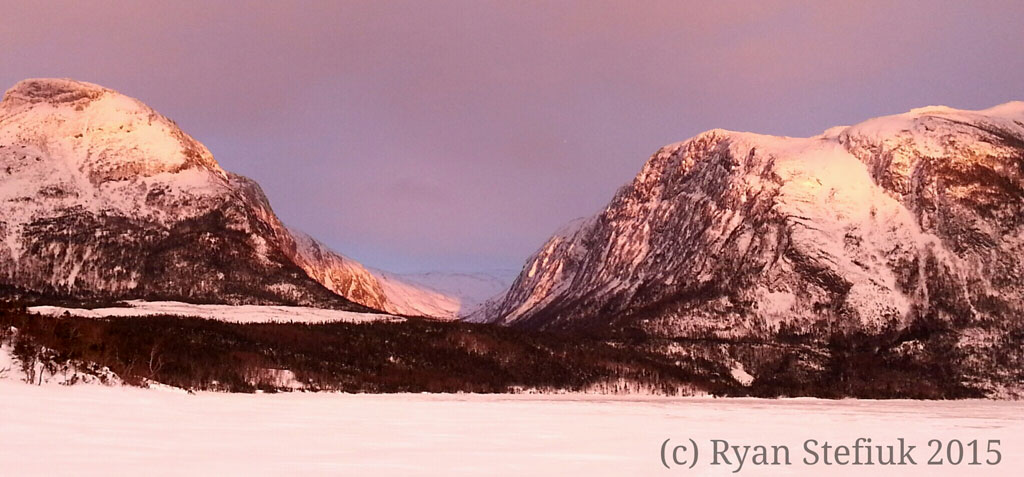
The MV (marine vessel) Leif Ericson crunches through sea ice in the Cabot Strait. The ship’s hull groans and 2-3 meter thick ice buckles underneath. Cracks in the ice expose the intimidating midnight blue waters of the North Atlantic. I see the long low hills of the Cape Breton Highlands off to my right, signaling our arrival in Nova Scotia and the end of my stay in Newfoundland. Leaving this place is always bittersweet. 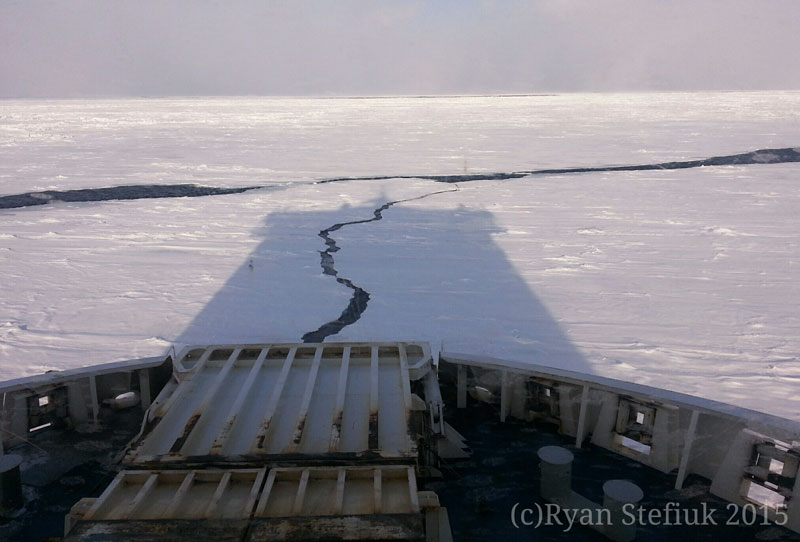 Winter trips in hideously cold weather make me long for home; to share a warm space on my couch or bed with my partner and dog. Newfoundland’s landscape and it’s people captivate me though and it saddens me to leave. I am deeply satisfied yet physically spent and tired of the cold.
Winter trips in hideously cold weather make me long for home; to share a warm space on my couch or bed with my partner and dog. Newfoundland’s landscape and it’s people captivate me though and it saddens me to leave. I am deeply satisfied yet physically spent and tired of the cold.
How does one measure the success of a climbing trip? Is it by how hard one climbed, or by whether one sent their project? Is it by the number of days climbed, areas visited, or routes completed? Can you measure success with first ascents? How about by the number of friends made or visited along the way?
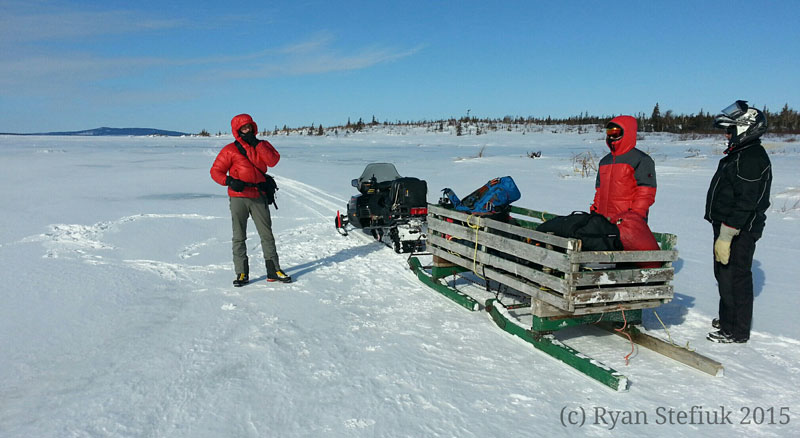 It’s hard for me to say exactly what made this trip to Newfoundland successful. Alden Pellett, Christopher Beauchamp and I got along great and laughed often, and that counts for a lot on any extended trip. Deep in the Newfoundland backcountry we climbed several really long ice lines – some as long as 1800′. Several of the lines we climbed were probably first ascents and check in at WI5+ or WI6. We climbed classic ice lines established by the Joe’s – Joe Terravecchia and Joe Josephson – on a wall that’s as classic as any 3 pitch wall in North America. We made new friends and reconnected with old ones. Newfoundland is famous for having gracious and hospitable people, and my expectations are continuously surpassed.
It’s hard for me to say exactly what made this trip to Newfoundland successful. Alden Pellett, Christopher Beauchamp and I got along great and laughed often, and that counts for a lot on any extended trip. Deep in the Newfoundland backcountry we climbed several really long ice lines – some as long as 1800′. Several of the lines we climbed were probably first ascents and check in at WI5+ or WI6. We climbed classic ice lines established by the Joe’s – Joe Terravecchia and Joe Josephson – on a wall that’s as classic as any 3 pitch wall in North America. We made new friends and reconnected with old ones. Newfoundland is famous for having gracious and hospitable people, and my expectations are continuously surpassed.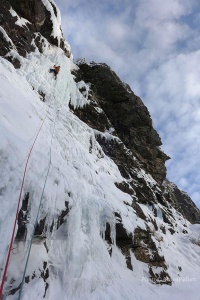
Over the years many people have climbed ice in western Newfoundland (pronounced newfin-LAND, with the accent on “land”). Paul Fenton, an outfitter in Nain, Labrador, climbed in many of the fjords, and Jim Bridwell spent some time there in the 90’s with him. In the late 90’s Joe Terravecchia and Casey Shaw began climbing there. They have explored the area heavily over the last 20 years, and have brought many other northeasterners along during that time.
It was one of Joe’s slideshows at the Adirondack Mountainfest that finally encouraged Alden Pellett and me to visit for the first time back in 2008. Initially, Joe and Casey were deliberately vague about where and what they’d climbed. This peeved me. I didn’t understand why anyone would be so secretive about the locations of climbs. Did they care so much about first ascents that they were unwilling to share information? Maybe, but I don’t think so. After five trips to the island, and 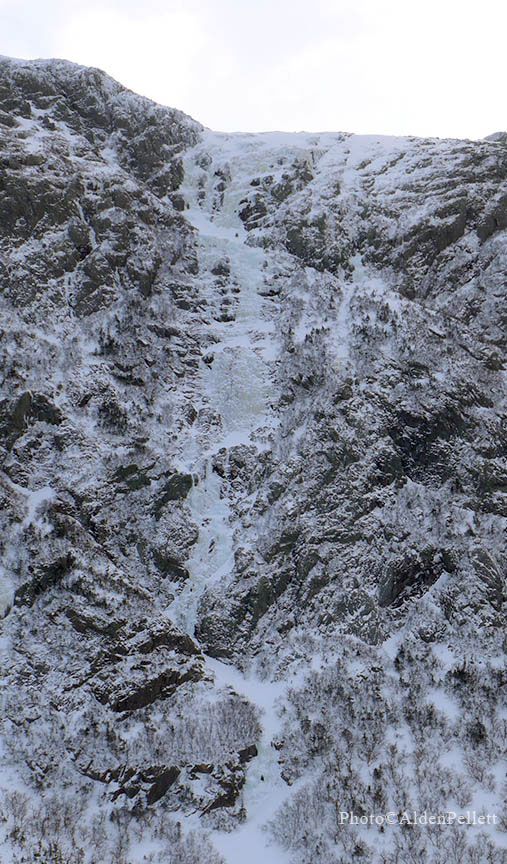 visits to many of the fjords, I realize the brilliance of their decision to keep quiet. It takes two days to get to Newfoundland during good weather. The wind and blowing snow is hideous. The climbs are all in the backcountry. There are no other climbers, no guidebooks, no bolts, and no chance of a timely rescue if something goes wrong. Ice climbing in Newfoundland is about adventure.
visits to many of the fjords, I realize the brilliance of their decision to keep quiet. It takes two days to get to Newfoundland during good weather. The wind and blowing snow is hideous. The climbs are all in the backcountry. There are no other climbers, no guidebooks, no bolts, and no chance of a timely rescue if something goes wrong. Ice climbing in Newfoundland is about adventure.
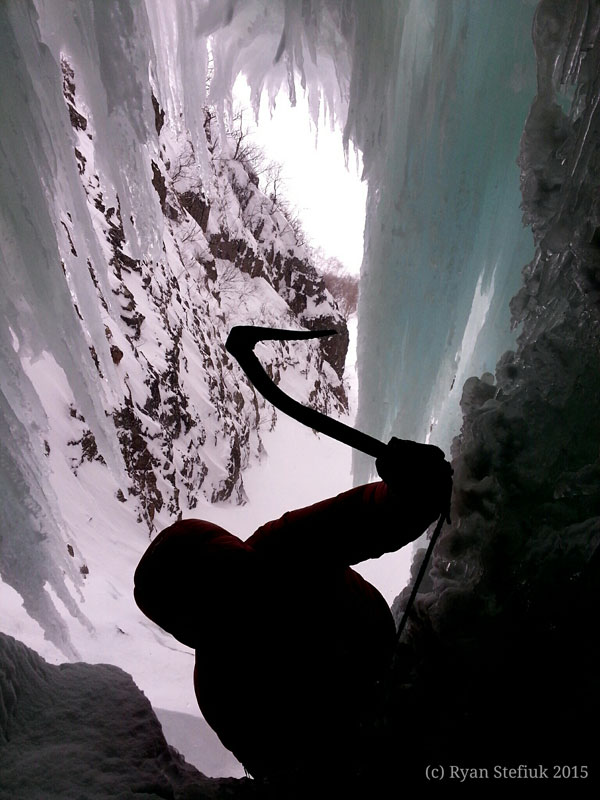 I know I’ll be back again. Maybe not next winter because I’ll be in nursing school. After that for sure though. Like those that have come before me, my vagueness about climbing in Newfoundland is deliberate. I want to preserve the experiences I’ve had and cherish so that others can be as fortunate as I have been.
I know I’ll be back again. Maybe not next winter because I’ll be in nursing school. After that for sure though. Like those that have come before me, my vagueness about climbing in Newfoundland is deliberate. I want to preserve the experiences I’ve had and cherish so that others can be as fortunate as I have been.
Many thanks to Terry Hynes, Bevin Goosney, Brad and Lamont Thornhill, Clayton, Rick Endicott, and Walt Nichol for showing us true Newfoundland hospitality. Thank you Casey Shaw and Joe Terravecchia for showing me the Newfoundland way. Thank you Michael and Alexa for letting us crash in North Conway before and after our trip and to Rob and Amy for letting us store a car in North Conway. All of these individuals helped make this year’s trip a great success.
by Kevin MacKenzie – adirondackmountaineering.com
The cold winter of 2015 seemed to last forever. Perhaps it was the weather, perhaps the weather in combination with the pressures of life. In any case, our plans came to life as the sub-zero spell finally broke. Our thoughts centered on putting up (creating) a new ice climbing route in Panther Gorge. I watched the weather as March 14th approached. The forecast called for temperatures in the 30’s Fahrenheit at our target elevation with a possibility of rain. Waiting for a different weather window was pushing the limits of ice season in the gorge, however.
I nearly threw the alarm across the room when it beeped at 3:55 a.m. I love alpine starts, but also needed the sleep—c’est la vie. As usual I spent a restless night pondering the uncertainties of the venture—would the snowpack be at least mildly supportive, could we dial in our approach, would the annoying ache above my left knee subside, would the rain be a problem, would the ice be safe…? We’d prepared as much as we could. The rest was in the hands of God and the weather.
I met Anthony and Adam at the Loj where we divided the climbing gear to distribute weight; our packs were each around 45 pounds between two ropes, protection and the normal winter necessities. Given the trail conditions we chose to carry microspikes, snowshoes and crampons; another three traction device day to add additional weight.
We began walking at 5:00 a.m. on rock hard trails. Fast forward to the bushwhack at 8:30 a.m. We left the Van Hoevenberg Trail high on Mt. Marcy after hiking almost 7 miles. If all went well, we’d thread our way through the cliffs and into the gorge. I can’t stress how dangerous this CAN be if you aren’t intimately familiar with the details of the gorge. It’s not the place to embark on a blind bushwhack—the last thing one wants is to descend 700 feet (especially in unbroken snow) only to find themselves 400 feet above the floor of the gorge.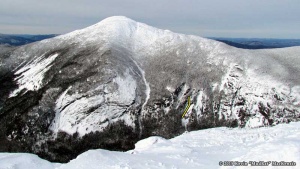
I took the first step off-trail and punched through a light crust to my shin. Spruce traps were thankfully infrequent. The terrain got steeper as we descended from the ridge and found a gully. There are many gullies in the area each with their own outlet; usually onto the technical climbing walls. Even high on the ridge there were obstacles, smaller ledges draped in ice. Adam eventually took point as Anthony and I checked the heading at regular intervals.
We soon found our jump-off into the gorge—ropes wouldn’t be necessary in these conditions.
A ridiculously steep gully led ever downward. Unsupportive sugar snow under a surface of crust made the descent a challenge. By now we were wearing crampons and they served us well. On a side note, Pi = 3.141592653… We were struggling down the gully at 9:26 a.m.—and 53 seconds on 3/14/15. Ok, I’m done channeling my inner geek.
We passed beside a wall that got ever taller as we descended into the heart of the gorge. The lines here were not covered in ice so we continued lower. Walking became easier as we reached some avalanche runout. It was like walking on blocks of concrete. We changed direction after climbing around a buttress and headed north to what I call the Overhang Slide. This is a relatively short slide with two large overhangs, one at the bottom and one near the top. I thought back to when Anthony and I enjoyed lunch on it last June. Adam and I climbed a portion of this during our last visit on December 7, 2014. I find it to be a place of particularly magnificent views.
Note: This is probably best accessed from the northern pass by continuing 800 feet southwest of the Agharta ice route.
We descended to the glade near the lower overhang and stared up at the wall of ice near the top, an enticing climb. We’d found our climb. I relaxed and scanned the gorge. The view north was largely occluded by trees, but Haystack loomed high and mighty across the way as small wispy clouds drifted across its summit. The beaver ponds to the south contrasted against the dark forest. I thought of the many people over the years who have gotten lost on Mt. Marcy and wandered into the gorge only to need rescue or, in the worst case, recovery. This is both a beautiful and unforgiving area.
Climbing
Adam began the route with a short vertical ledge preceding the low-angle slab. A couple hundred feet higher, he set up a belay from a tree near the upper overhang. Anthony and I climbed the snow/ice at the same time, each on our own rope. It felt odd being on a rope since this is the type of terrain that I normally solo.
We surveyed the scene from the anchor near the upper overhang. The ice was beginning to rot so the purely vertical pitch was out, but there were several other options. The cloud ceiling was in the process of lowering, Haystack had disappeared. The cliffs to the north, however, were still in view. The great ice route of Agharta was in shambles with only the top intact. The slabs were free of winter and wet with runoff.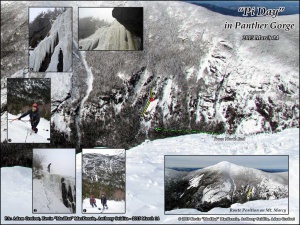
The fog up-drafted as Adam climbed the left-hand side of the icy wall. It was tedious work as he chipped through the rotten ice to place the screws into more substantial ice. It was an appealing line that included some short vertical sections and a couple small ramps. He led it to the top left-hand corner of the wall. By now the gorge was socked in and a light sleet had transitioned to rain. Thank God for protective layers.
Adam belayed me as I climbed. From the top, the view was obscured yet awesome. Anthony climbed next. I listened to the wind and the sound of ice falling as he chipped his way up—this is what I consider serenity. The rappel down to our packs at the lower overhang went without incident. Our route, “Pi Day”, was completed by around 1:30 p.m., but the day was far from over. We ate lunch and contemplated our exit; it would be grueling.
Exit
By the time we reached the bottom of the gully again, I was thankful for the avalanche debris—finally something stable underfoot before the crux of the exit. The next 300 feet of ascent over 450 ground feet was heinous and spent on all fours digging for traction. Adam was in the front climbing like a phantom in the fog. An occasional chunk of crust bounced off my helmet so I knew he was moving. In the meantime, Anthony was reorganizing his pack below. I began to ascend and watched Anthony slowly dematerialize in the mist. Adam used snowshoes, Anthony and I used crampons. I’m not sure which was better, but the ordeal seemed endless. Yup, this is what we call fun, but nothing good is easy!
The following 600 feet of elevation gain involved no navigational skills, just retracing our steps and overcoming the occasional ledge of unsupportive snow. It’s amazing how much energy one can expend moving 6 feet. Cresting Marcy’s ridge was like arriving at the promised land. Conditions were windy and the high level clouds were thickening. We reached the Phelps trail intersection at around 3:30 p.m. and changed gear. Adam switched to skis which made his descent fun and relaxing by comparison. We arrived back at the Loj at 5:30 after about 12.5 hours of adventuring over 14.75 miles/4,400 vertical feet. Thus ended another wonderful day in Panther Gorge.
A good day is the culmination of good planning and great partners; thanks again to both of you!
Topo Map of the Area
[mappress mapid=”5″]The first ascent of the Black Dike on Cannon Cliff each year has always been the herald of the new ice season. This year, it came early and swift!
Yesterday morning, Majka Burhardt and Alexa Siegel worked their way up the route in lean and mean conditions, providing high-quality early ice season stoke. Burhardt led the route and the two were back in the sun at the parking lot at 1:00 pm after a dozen good ice sticks, 40 times that of thin sticks and mixed moves, and two bouts of screaming barfies over three pitches (a piece).
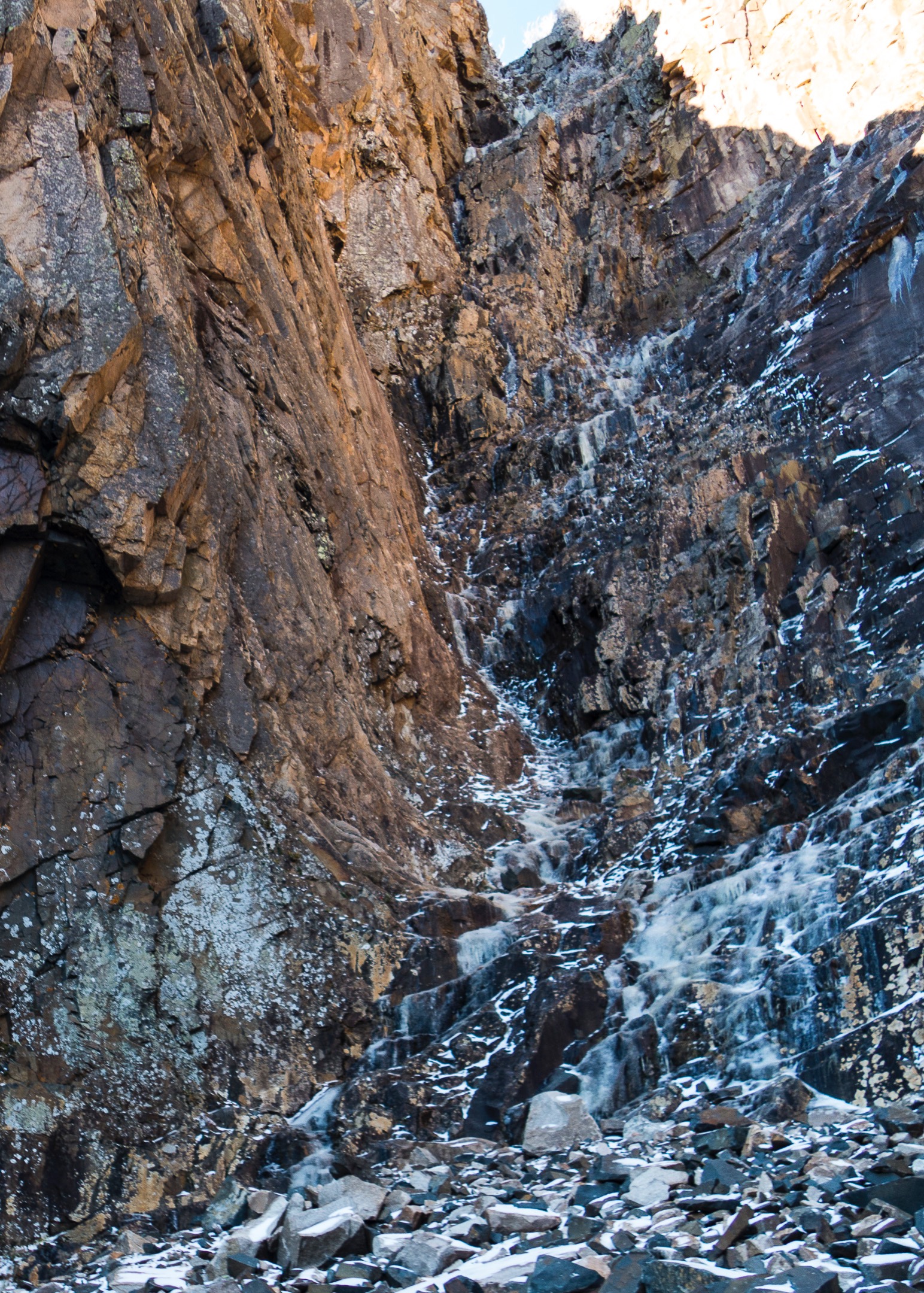
View up the Dike, 7:45 am October 19th and the moment of “Oh yeah! It’s in.” Photo by Majka Burhardt.
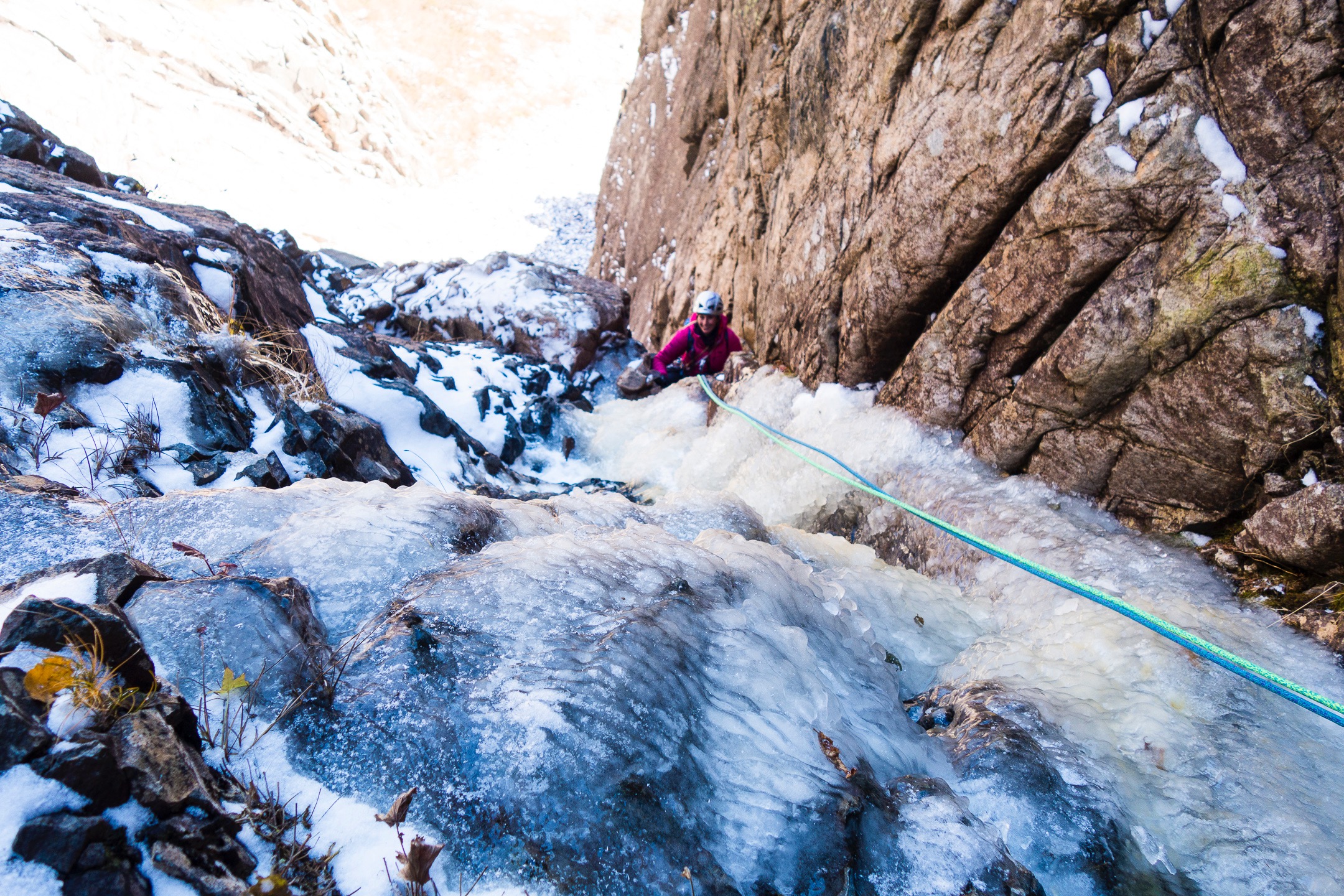
Pitch two was dry on the traverse, a bit of everything in the hose, and sticks up top. Alexa finishes it off. Photo by Majka Burhardt.
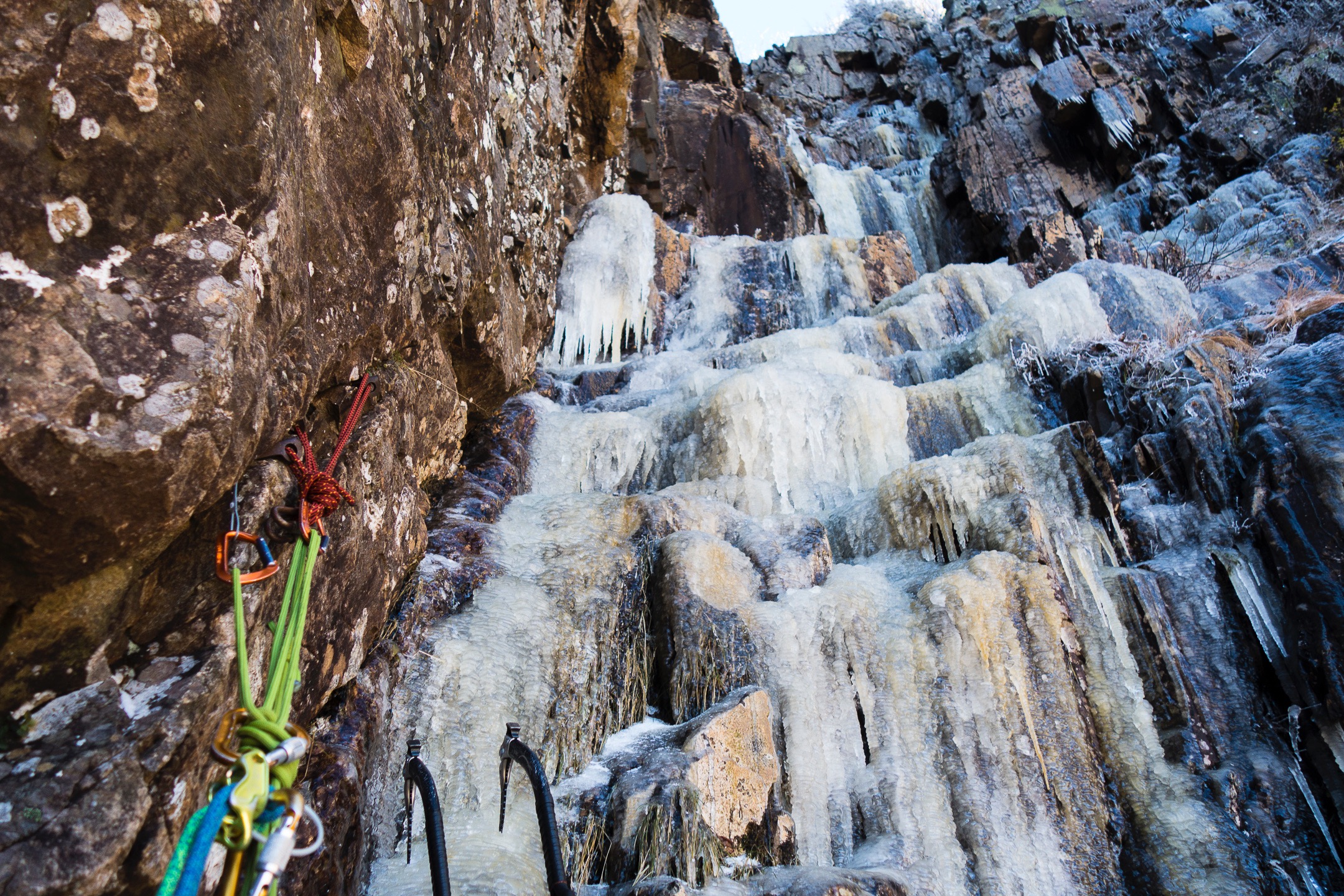
Looking up the final pitch— which (surprisingly) gave the most thoughtful climbing of the three. Photo by Majka Burhardt.
“Ice season is ON— don’t let anyone tell you otherwise.” – Majka Burhardt
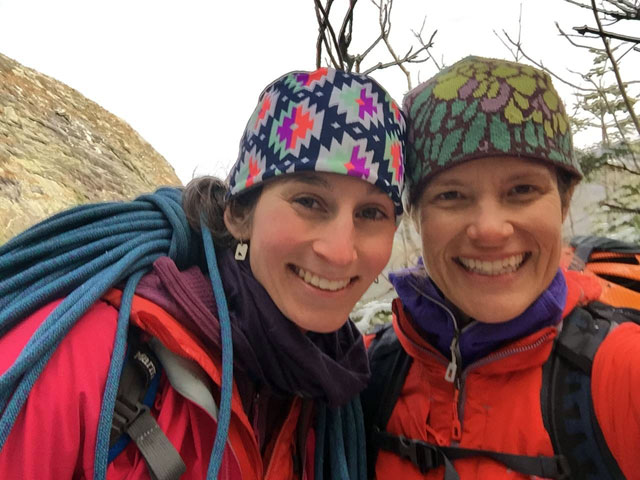 Alexa Siegel works year round as a climbing guide for Cathedral Mountain Guides, Mooney Mountain Guides, The White Mountain Climbing Camp and The Kismet Rock Foundation. Last winter, Janet Wilkinson and Alexa started a Ladies Only Climbing Series with Cathedral Mountain Guides teaching women of all abilities ice climbing and mountaineering skills. She is a grassroots athlete for Outdoor Research and a member of Mountain Rescue Service.
Alexa Siegel works year round as a climbing guide for Cathedral Mountain Guides, Mooney Mountain Guides, The White Mountain Climbing Camp and The Kismet Rock Foundation. Last winter, Janet Wilkinson and Alexa started a Ladies Only Climbing Series with Cathedral Mountain Guides teaching women of all abilities ice climbing and mountaineering skills. She is a grassroots athlete for Outdoor Research and a member of Mountain Rescue Service.
Majka Burhardt is an author, professional climber, filmmaker, and the founder/director at Additive Adventure. She is an ambassador/athlete for Patagonia, Osprey Packs, Positive Tracks, Petzl, Scarpa, and Julbo and an American Mountain Guides Association Certified Rock Guide.
Find Majka at www.majkaburhardt.com and follow her at https://instagram.com/

Your ice climbing connection for New England, the Northeast and Beyond!
